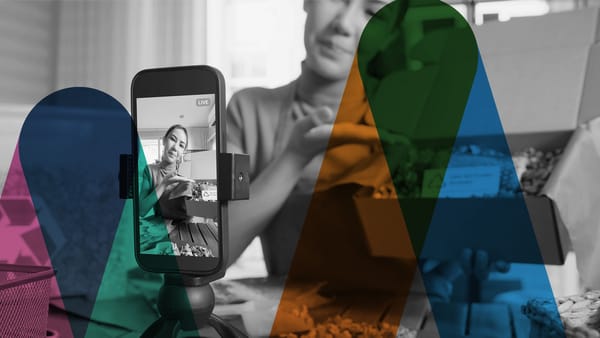Picture the TikTok scene: it’s the run-up to Christmas and, in classic unboxing style, a fashion influencer is showcasing her “Christmas presents” from a designer fashion brand. A festive tune plays as she opens one gift after another – until accidentally dropping and smashing a set of glass Christmas ornaments.
These aren’t just any Christmas ornaments, either. A casual Google will tell interested viewers these have an RRP of £380.
After subsequent, similar videos emerged, TikTokers posted viral conspiracy theories: Perhaps it was part of a shock-tactic campaign? Or maybe the influencers copied one another? But Tyler McCall, editor-in-chief at Fashionista explains the real reason is far more simple. The packaging was precarious and, she says, “there’s a carelessness with influencers who didn’t pay for these things.”
Mystery solved. But this story highlights a potential uneasiness around a common marketing tactic in fashion: influencer gifting. It also points to a growing interest amongst young consumers in discussing and dissecting how they are being marketed to. As the cost of living crisis develops this year, marketers will need to pay even more attention to how their influencer gifting campaigns will materialise.
How can fashion brands and influencers still unlock all the benefits of influencer marketing through influencer gifting, and avoid alienating their audiences?
Establishing trust
Influencer gifting is commonplace for a reason. Brands must get their products to influencers to market them – and influencer marketing works. It’s an especially powerful method to reach Gen Z, the largest consumer generation, who dislike most forms of advertising yet trust influencer recommendations – when done right.
How can brands and influencers unlock this lucrative trust instead of prompting the scepticism seen in the example above?
A key component to the answer is to take a more considered approach to partnerships. Hannah Cole, Senior Creative Strategist at Fanbytes by Brainlabs advises that “brands should be aware that young people know when they’re being marketed to – and they don’t actually mind most of the time […] But what gets them suspicious is when it feels like they’re being opaque.”
Establish transparency, then move on to focusing on providing content that resonates. Her tips for this are:
- Partner with influencers whose style and price point clearly resonate with the gifted product. “As a rule, micro-influencers are great for reviews of high-street clothes that followers can go out and buy, whereas macro-influencers are inspiration for most people.”
- Give influencers an opportunity to talk about their relationship with the product. This creates space for creativity, and “feels so much more genuine.” Partner with influencers who will truly care about the gifted product: this is the way to more authentic stores – and fewer accidents.
- Create opportunities for influencers to feature the gifted product in their own content style. These creators’ followers engage with them for a reason. “If you’ve picked the right influencer, their content style should already suit your brand. Asking them to do something completely different could look fake.”
Communicating value
What about influencers receiving gifted items from fashion brands this season? As Christmas 2022 approaches, creators will be navigating a landscape of “brand scepticism for entertainment” alongside speaking to followers who are facing growing economic inequality.
Creators whose digital footprint relies on product promotion will likely suffer if they don’t address the crisis. Many rely on a close relationship with their followers, so it will be important to create content that resonates and appeals to them to maintain this relationship. Here are some avenues to consider:
- Audiences will be looking to make smaller, more conscious purchases. Many influencers will adapt to reflect a growing desire for second-hand fashion. Consumer relationships with fast fashion will become more complex; influencers will need to demonstrate quality or value for money. Hannah expects to see “styling videos with multiple outfits for each gifted item, mixed in with older pieces that everyone has in their wardrobe.”
- Consumers are likely to conduct more research into products before purchase. Fashion influencers can help by providing detailed information about gifted products to inspire trust. Rather than simply showing items, influencers should give more information than customers would find on the e-commerce site, so audiences get extra value from influencer content. This will drive sales conversions.
- Influencers will need to demonstrate steps they take to reduce waste. Donate excess items, and thoroughly research new brands before working with them. Take steps to ensure you can definitely post about any gifted products – this will be especially important when requesting from small businesses. This transparency will foster trust from brands and followers.
Clarifying relevance
Influencers who are going to survive and thrive in the current climate are those that have a social cause or genuine passion at the heart of their activity. Both brands and influencers will need to consider how to create content that’s useful, current, and relevant to their followers’ needs.
But, as Hannah notes, influencer marketing – and influencer gifting – needn’t always be doom and gloom. “People come to social media for entertainment, and some influencers are great for pure escapism. […] I’m not sure I’d want to see every single fashion influencer in my feed posting about the cost of living.”
“If a macro-influencer who normally wears Chanel is posting about getting wears out of a £5 top, that content probably wouldn’t be useful to its target market. And it could even feel patronising.”
Instead, a modus operandi of examining and clarifying the influencer-brand relationship means that creativity can thrive. Doing so ensures marketers can create strategies that capture different influencers’ strengths and create content that excites audiences – without switching them off.
Fanbyes by Brainlabs’ Advanced TikTok Fashion Guide provides insights on how fashion marketers can use layered influencer storytelling to create a sense of relevance and textuality around their brand. It’s a great resource for brands looking to turn TikTok presence into tangible value.
Wrapping it up
Thanks in part to advertising transparency laws, social media audiences have come to expect that a large proportion of the products they see sported by influencers are gifted.
The cost of living crisis should present an opportunity for brands and marketers to take a keener look at those more relatable and hard-working smaller influencers who are helping their followers through the crisis, and consider how they can use tiered influencer marketing strategies to access different audience segments with the right message.
Brands and influencers need to partner more closely with one another to deliver unique, interesting content that’s meaningful for the brand, influencer and the target customer while being relevant in today’s culture. As the cost of living crisis continues, any partnership must highlight this value exchange. But those that can do so successfully will capture the hearts of customers and create value in the long term.
And if fewer glass baubles get damaged in the process, that’s a great – or smashing? – start.








